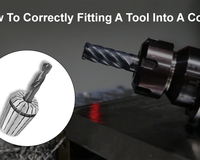The difference between climb milling and conventional milling centers around the rotation of the tool in relation to the table feed.
In climb milling operations, the cutter rotates with the feed. Because CNC milling machines have no to very little backlash in the lead screw, this procedure is best employed proactively on a CNC machine. When running at higher RPMs and feed rates, the swarf is evacuated behind the cutter, reducing the possibility of re-cutting the waste material.
During conventional milling, the tool rotates in the opposite direction as the feed rate. This form of milling is often employed on manual machines, and it allows the table to pick up the slack in the lead screw, allowing the machine table to retain a precise position.






